6 Yoga Exercises to Help You Sweat, Along with Additional Sun Salutations
There's no doubt that sweating while practicing yoga does wonders for health and well-being. Which yoga poses are best?
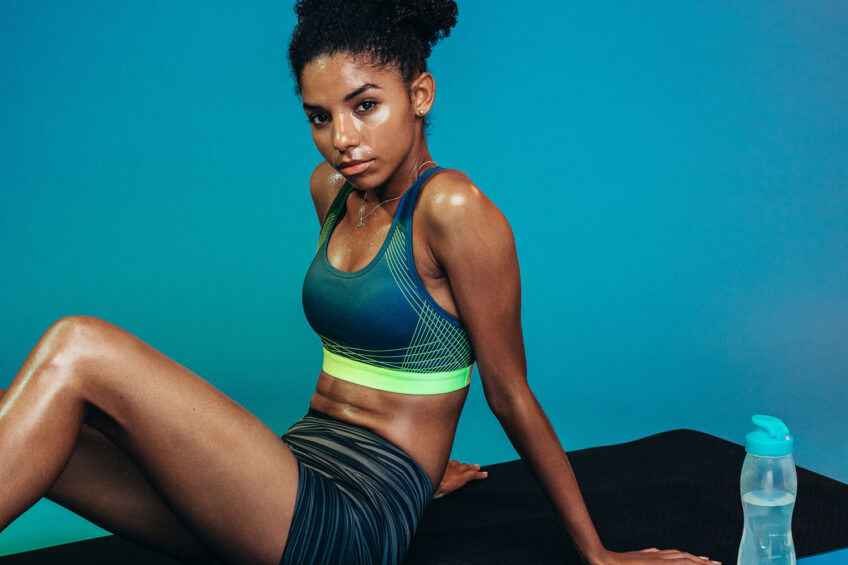
Despite what many people will tell you, there’s no ideal length yoga class. And, while you might prefer to spend 90 minutes on the mat a few times a week, the reality is that you probably won’t get there as often as you like.
What’s the alternative? Well, my thinking (supported by research) is that something is better than nothing. It’s far better to spend 30 minutes of focused time doing yoga four times a week than saving yourself up for a 90-minute class on a Saturday morning that you might not even wake up in time for.
There are two studies worth looking at here. In the first, researchers showed that a 20-minute yoga session led to a temporary improvement in working memory, and a second showed that a 12-minute yoga session 4 to 7 times a week improved bone density. So, like the tortoise and the hare story, consistency wins.
I’ve learned to give myself a break. If it’s not realistic to try to get to a class, then unrolling my mat at home and going through a few sweat-inducing poses is much better than flopping down on the couch at the end of a long day.
I tend to go for high-intensity yoga (if there is even such a thing) because it’s only 20 minutes, and I want to make it count. This means that I go all in – and by the end, my muscles are burning, and I’m always dripping with sweat.
Before we get into the poses, I wanted to cover two quick questions that come up a lot:
Is it normal to sweat while practicing yoga?
When it comes to yoga, just about anything goes.
And if you sweat more than others during a regular, unheated yoga class, don’t worry -- it’s completely normal.
First, the amount you sweat will depend on the type of yoga you’re doing. You’ll sweat more if you’re doing a Bikram or Core Power class than a restorative yin-yoga class. And second, especially if you’re a beginner, you will sweat a lot more than others as your body works harder to do the poses.
If you find that you’re sweating a lot, don’t worry about trying to change that, make sure you’re prepared, which means:
Drinking water - you need to stay hydrated, and since sweat is 98% water, you need to drink water before, during, and after a yoga session. (But not too much because that feeling of water sloshing around your insides while doing Downward Dog will make you feel nauseous).
Taking a towel - a yoga mat towel to protect your mat and a yoga hand towel will be your best friend while you sweat it out.
Listening to your body - if you’re pouring with sweat (especially if it’s a hot yoga class), you must listen to your body and ensure you’re not overstretching or injuring your muscles. Remember, you can always take a break.
Using the right yoga mat - a non-slip yoga mat (along with a yoga towel) will help you keep from falling during the class, as all the sweat can quickly make things slippery.
Is it good to sweat during a yoga session?
There are a couple of thoughts on the benefits of sweating during yoga, including detoxification (where impurities are removed from your body through sweating).
Unfortunately, there isn’t much research to back this up, but sweating benefits you by performing the function it was designed for: keeping you cool.
If you’re sweating a lot, your body is working hard to regulate your temperature so that you’ll be able to keep going with the class. Sweating also lets you know that your body is working, which can be a powerful motivator to keep going!
So, if sweating is completely normal and has some benefits, let’s look at six poses that will get you sweating, even if you only have 20 minutes on the mat.
Let’s get your body moving and the sweat dripping with these six yoga poses!
1. Downward Dog (Adho Mukha Svanasana)
I like to start my yoga sweat sesh with a bit of a warm-up, and downward dog is always a winner because it ignites the flow of energy through your whole body and offers a deep stretch for your spine, hands, calves, hamstrings, and shoulders.
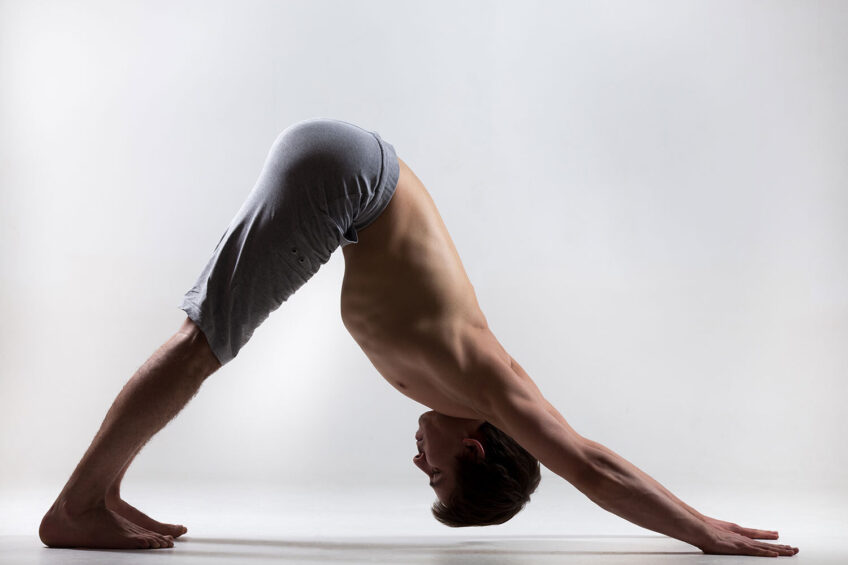
Regular downward dog practice can relieve back pain (I’ve experienced this first-hand), help with sinus blockages, and improve digestion. It’s also a mild inversion linked to relief from headaches, fatigue, and mood disorders.
And, with blood flowing to the brain, it can calm and relieve stress while improving memory. The list of benefits goes on and on!
- Start on your hands and knees. Check that your wrists align with your shoulders and your knees are directly under your hips.
- Relax your upper back, stretch your elbows, and spread your fingers wide, pressing through your palms. Check that your weight is evenly distributed across both hands.
- Exhale, tuck your toes, and lift your knees, reaching your pelvis up, then straighten your legs (without locking your knees).
- With your body in the shape of an A, focus on lifting through the pelvis and pushing the floor away.
- Rotate your arms externally so that the creases of your elbow face forward.
- Hold for 20 breaths or as long as you can manage without losing form.
2. Boat Pose (Navasana)
Now that you’re feeling a bit warmer, it’s time to crank up the intensity.
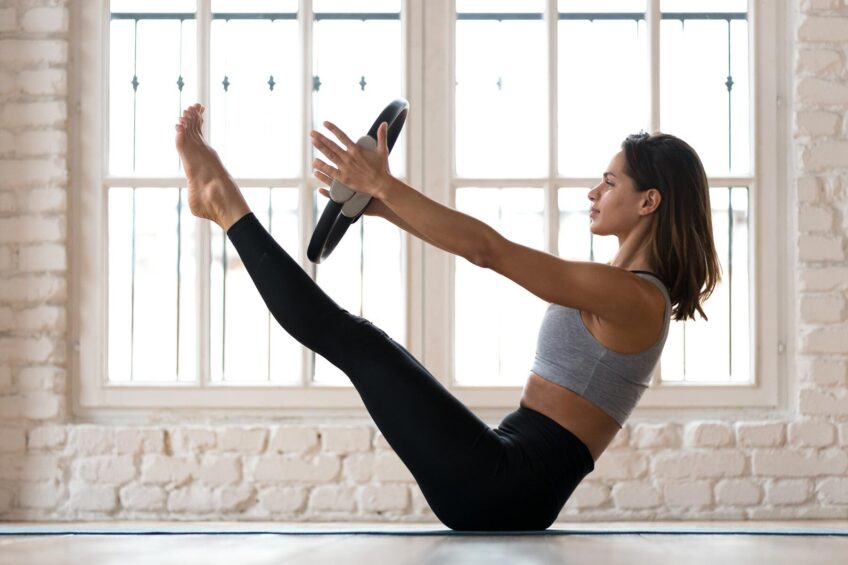
This pose takes a bit of time to get comfortable with as it is a huge challenge for your spine, hip flexors, and abdomen, making it ideal for building rock-solid core strength. It’s also linked to improved digestion, metabolism regulation, and stress relief.
Spoiler alert: this is a tough one!
- Start seated with your knees bent and feet flat on the flow. Focus on breathing in and out.
- Lean back slightly with a straight spine, lifting your feet so your shins parallel the floor.
- Extend your arms in front of you, in line with your shoulders, and keep your palms facing each other. Keep your lower back in line with your spine and lift your chest.
- Balancing on your sit bones and keeping your spine straight, exhale and straighten your legs until they make a 45-degree angle with the ground so your body is in a V shape.
- Keep looking at your toes, ensure your core is engaged, and hold the pose for five breaths.
- As you build core strength, lengthen the time you hold the pose, working up to 1-2 minutes.
3. Chair Pose (Utakasana)
The Chair Pose works your whole body by stretching (Achilles tendons, shins, shoulders, and chest), toning (shoulders, glutes, hips, and back), and strengthening (thighs and ankles).
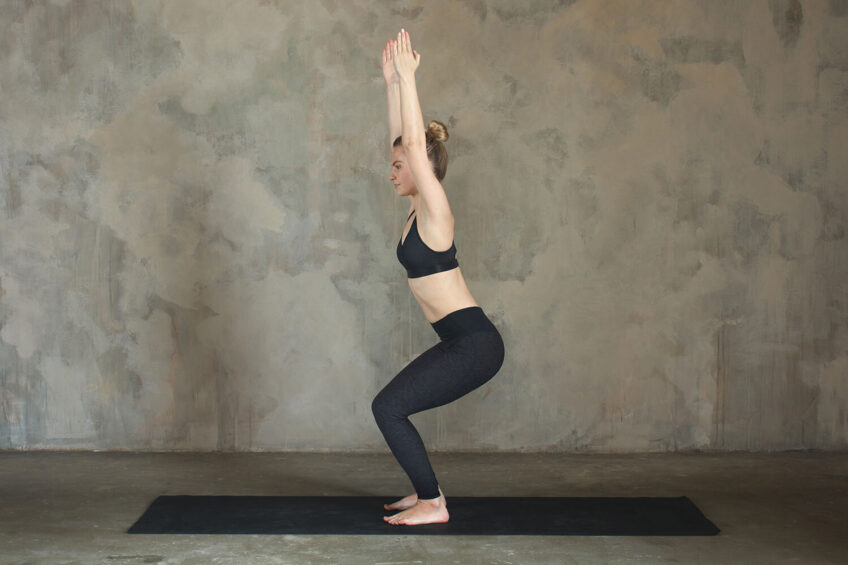
- From a standing position at the top of your mat, place your feet about inner-thigh width distance apart with your toes facing forward.
- Reach your arms over your head and turn your palms to face each other.
- Slowly bend your knees, then, keeping your knees over your feet, shift most of your weight onto your heels and reach your seat back.
- Let your upper body lean forward slightly to form a 90-degree angle with your thighs.
- Draw your shoulder blades down and towards your spine, and try to lengthen your tailbone, stretching your spine.
- Hold the pose for as long as is comfortable without losing form, up to 60 seconds.
4. Warrior III (Virabhadrasana III) with High Lunge
This pose has it all - back and forward bending combined with balance and coordination. Warrior III is a fun challenge you’ll need some time to master, but it’s definitely worth the effort.
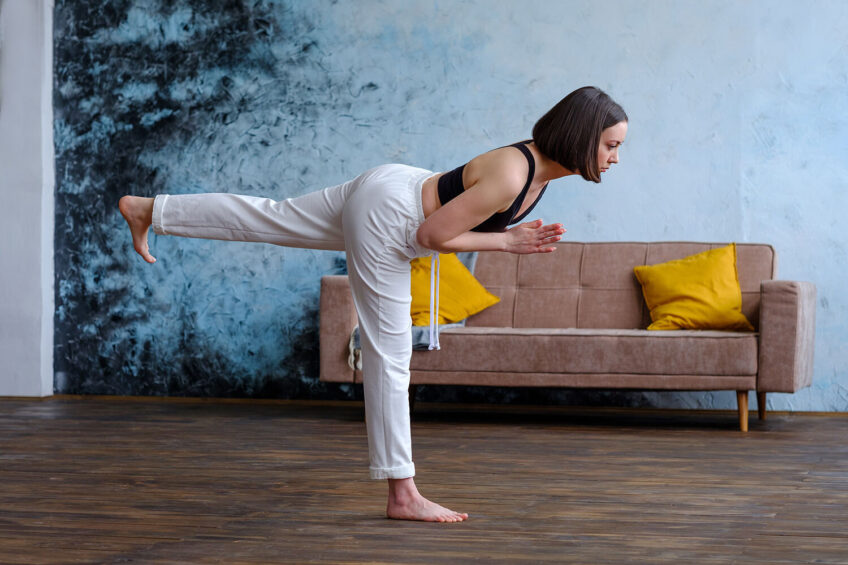
Warrior III will work the back of your body from your shoulders right down to your ankles while also targeting the abdominals.
- Starting in High Lunge, right foot forward, place your palms together in front of your chest in Prayer Position (Anjali Mudra).
- Engage and lift your pelvic floor, and activate your lower abdominal core muscles for stability.
- Exhale, bend from your hips and lower your body to make a 45-degree angle with the floor and find a point on the floor to focus on.
- Inhale, find strength in the front foot, and slowly shift your weight forward, lifting the back foot from the floor.
- Exhale and slowly straighten your standing leg, lifting your back leg until it is parallel to the floor.
- Hold the pose for five breaths, bend the front knee, and slowly return to High Lunge.
- Take a moment in Downward Dog or Mountain Pose, then repeat on the other side, moving your left foot forward into High Lunge.
5. Plank Pose (Phalakasana)
Whether you’re a regular yogi or have never stepped into a yoga class, the one pose that you’ll definitely be familiar with is Plank Pose. It’s a strengthening and toning pose focusing on the arms, wrists, spine, and abdomen. It’s great for improving your posture and will prepare your body for more challenging poses that require additional arm strength.
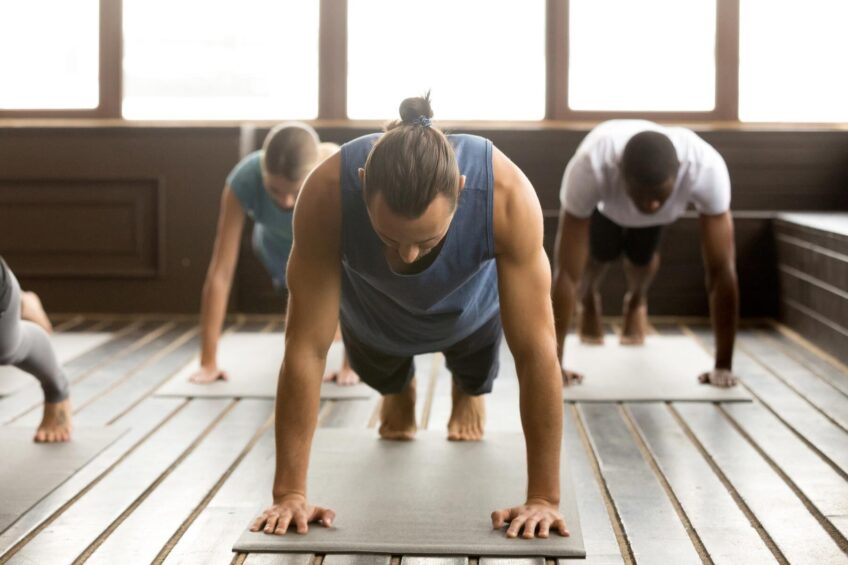
- Get into a push-up position with your hands directly under your shoulders, then do a whole-body check.
- Your fingers should be spread wide apart with the middle finger pointing forward.
- Press your weight into your palms, and keep your arms straight (without locking them)
- Tuck your tailbone under so your legs, hips, and upper body form one straight line.
- Hold the pose, breathing in and out, for as long as possible while maintaining correct form.
6. Child’s Pose (Balasana)
This is my favorite one of all, mostly because it means that you’re getting a break from all the other more intensive poses, and in this case, it means that you’re nearly done. This restful pose is a great way to end as your heart rate can begin to slow down, and you can take a moment or two of mindfulness to reflect on your practice (and give yourself a mental high-five for getting through).
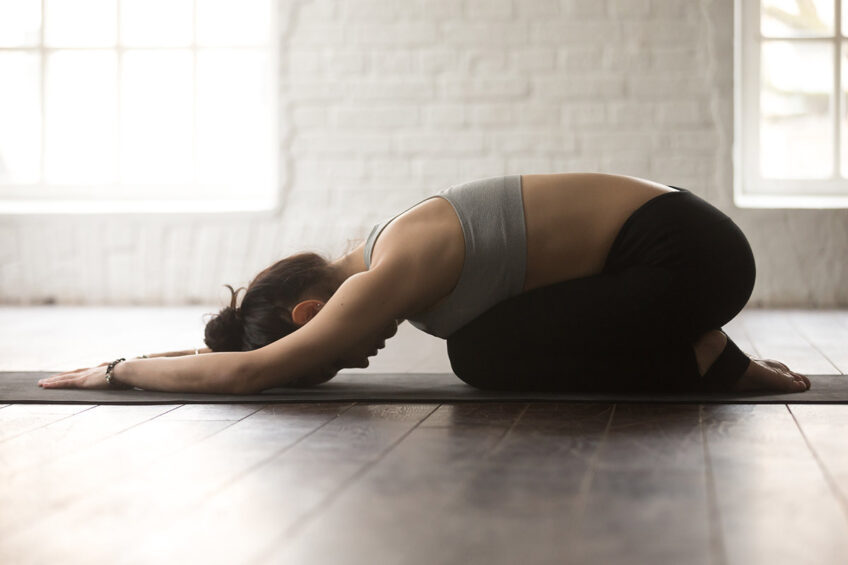
And, even better, while you’re in this rest pose, your body is still working as child’s pose stretches out the hips, thighs, and ankles as well as relaxing muscles on the front and back of the body, which have all taken a bit of a beating over the last 15 minutes.
- Kneel on the floor and bring your big toes together until they touch. Sit on your heels, then move your knees hip-width apart in a V shape.
- Exhale, lying your upper body down between your thighs. Concentrate on lengthening your tailbone.
- Lay your hands down alongside your body with palms facing up and feel the front of your shoulders pulling your shoulder blades wide across your back.
- Stay in the pose for 30 seconds to a minute...or three if you need a breather!
Are there any other yoga sweat poses?
A review of 17 different yoga studies found that, in general, yoga is a light-intensity form of exercise. Still, a few poses fall into the next category of moderate to vigorous intensity.
The sun salutations (Surya Namaskar) are in this group, so if you only have 15 minutes, you could choose Sun Salutation A, B, or C to start your day on the right note.
Sun Salutation A
- Standing Mountain Pose (Tadasana)
- Upward Salute (Urdhva Hastasana)
- Standing Forward Fold (Uttanasana)
- Half Standing Forward Fold (Ardha Uttanasana)
- Four-Limbed Staff Pose (Chaturanga Dandasana)
- Upward-Facing Dog Pose (Urdhva Mukha Svanasana)
- Downward-Facing Dog Pose (Adho Mukha Svanasana)
- Half Standing Forward Fold (Ardha Uttanasana)
- Standing Forward Fold (Uttanasana)
- Upward Salute (Urdhva Hastasana)
- Mountain Pose (Tadasana)
Sun Salutation B
- Chair Pose (Utkatasana)
- Standing Forward Fold (Uttanasana)
- Half Standing Forward Fold (Ardha Uttanasana)
- Four-Limbed Staff Pose (Chaturanga Dandasana)
- Upward Facing Dog Pose (Urdhva Mukha Svanasana)
- Downward Facing Dog (Adho Mukha Svanasana)
- Warrior 1 (Virabhadrasana I)
- Four-Limbed Staff Pose (Chaturanga Dandasana)
- Upward Facing Dog Pose (Urdhva Mukha Svanasana)
- Downward Facing Dog (Adho Mukha Svanasana)
- Warrior 1 (Virabhadrasana) - on the other side
- Half Standing Forward Fold (Ardha Uttanasana)
- Standing Forward Fold (Uttanasana)
- Chair Pose (Utkatasana)
Sun Salutation C
- Standing Mountain Pose (Tadasana)
- Upward Salute (Urdhva Hastasana)
- Standing Forward Fold (Uttanasana)
- Half Standing Forward Fold (Ardha Uttanasana)
- Lunge, Right Leg Back
- Plank Pose (Kumbhakasana)
- Knees, Chest, and Chin Pose (Ashtanga Namaskara
- Cobra Pose (Bhujangasana)
- Downward-Facing Dog Pose (Adho Mukha Svanasana)
- Lunge, Right Leg Forward
- Standing Forward Fold (Uttanasana)
- Upward Salute (Urdhva Hastasana)
- Mountain Pose (Tadasana)
My thoughts?
I could always choose the couch over more exercise. But I love the feeling you get after a great yoga or HIIT session.
So, this 20-minute intensive session that combines stretching with some hardcore sweat-inducing get-the-heart-pumping poses is a great mix for me. It’s ideal for getting the most out of your twenty minutes, and squeezing into a busy day is easy.
But, even more important for me is that you can do it anywhere, and because it’s so short, you really don’t have any excuse not to do it (and I’m the queen of excuses!)
Jessie Clayton
Jessie Clayton is a highly regarded yoga instructor (RYT 500) and certified nutritionist dedicated to guiding individuals on their journey to holistic well-being, with over 5 years of experience in yoga and nutrition. Jessie is an avid Christ follower and passionate advocate for the harmonious integration of mind, body, and spirit.










